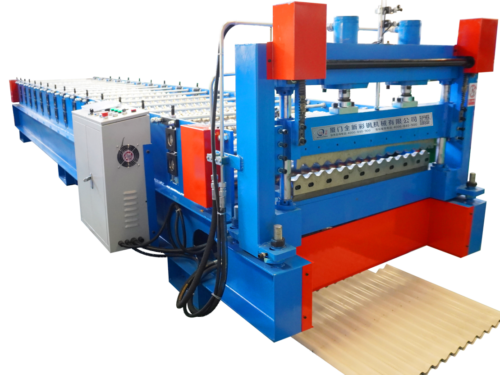Double Layer Roofing Roll Forming Machine
Introduction

Components and functions
1. Sheet guide equipment: The sheet guide equipment used is a guide rod slider type. This design allows for easy adjustment of width and left and right position.
2. Main machine drive: The main machine drive system plays a vital role in the operation of the machine. It is used to transmit the power generated by the main motor to the roller through chains and sprockets. At the same time, it is responsible for transporting the coils to achieve a continuous and seamless production process.
3. Roller forming system: The main frame of the machine is manufactured through a separate welding process. The roller is manufactured with the highest precision using advanced machine tools and then undergoes a surface chrome plating process.

Product Advantages
1. European Standard Quality Assurance: Our products strictly comply with European quality standards.
2. High-quality material and component selection: We spare no effort to find the best materials and components for our products.
3. Professional team dedicated to meeting your needs: Our products are supported by a team of experts with more than 28 years of industry experience, benefiting from in-depth knowledge and technical expertise.
4. Best price-performance ratio: In the current market, our products stand out for their excellent price-performance ratio.
5. Tailor-made solutions for you: Whether it is to modify the characteristics, functions or specifications of the product, our team of experts will work closely with you to develop personalized solutions that are perfectly suited to your specific applications and requirements.
Product Features
1. Certification: Our products have ISO 9001 and CE certification.
2. Lifetime service: We are committed to providing you with comprehensive lifetime service.
3. Advanced control system: The machine is equipped with a state-of-the-art control system, including Mitsubishi PLC and touch screen interface.
4. High-quality rollers: Our rollers are carefully designed for long-lasting performance. They are coated with a 0.05 mm thick chrome layer. The rollers are supported by a solid steel shaft with a diameter of 82 mm and have a service life of more than 10 years.
5. Low manpower requirements: Our machines are designed with efficiency in mind and can be operated by at least one worker.
6. Special treatment of cutting blades: The cutting blades of our machines undergo a special heat treatment process. These blades are made of Cr12 die steel and are quenched to increase their hardness and durability.
7. Fixed-length cutting function: Our machines are equipped with a fixed-length cutting function, which allows you to produce products of the exact length required for your project.
8. Overseas installation and training of technicians: We provide overseas installation and training services provided by professional technicians.

Machine Parameters
| Item | Specification | |
|
Material |
Type | Pre-painted steel coil & galvanized coils |
| Thickness | 0.3-0.7mm | |
| Yield strength | 235Mpa or 550Mpa | |
| Roller material | GCr15, with hard chrome coating 0.05mm | |
| Forming speed | About 20m/min | |
| Forming Station | 18 | |
| Shaft Diameter | 75mm | |
| Cutting mode | Hydraulic cutting | |
| Cutter material | Cr12 mould steel | |
| Length measurement | Encoder | |
| Control mode | Mitsubishi PLC | |
| Operating mode | Button + Mitsubishi Touch screen | |
| Main motor | 7.5KW | |
| Hydraulic station motor | 2.2KW | |









Reviews
There are no reviews yet.